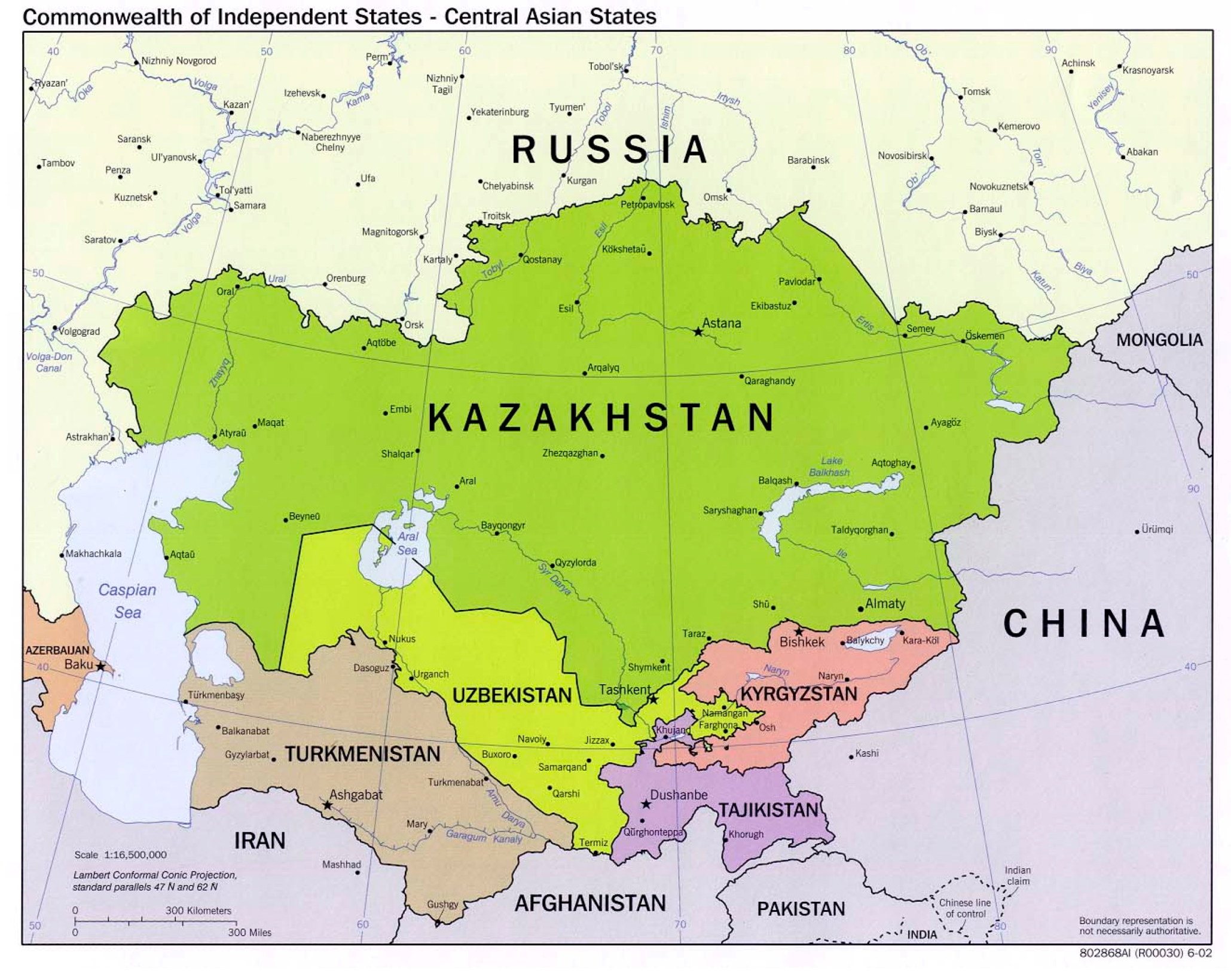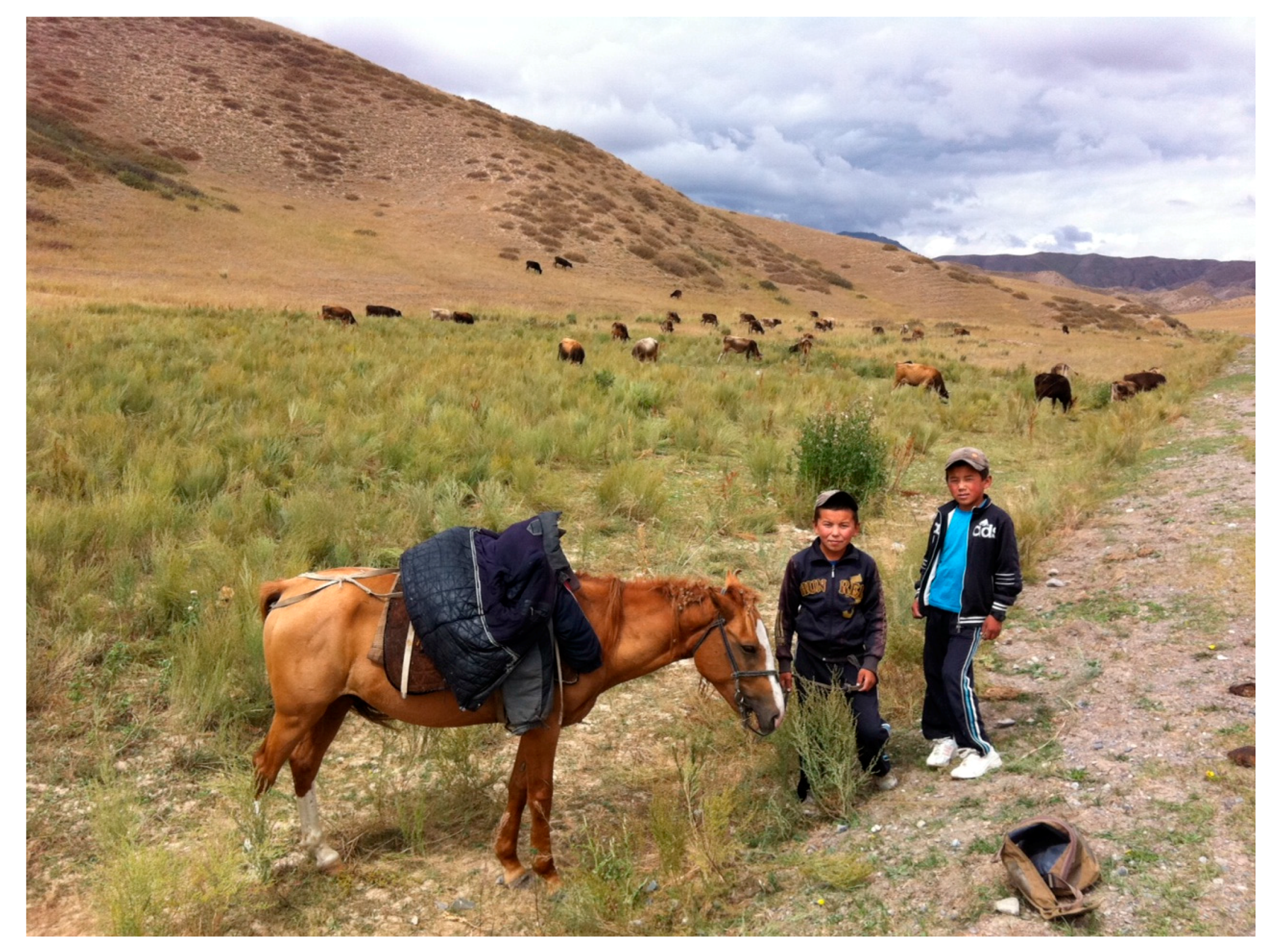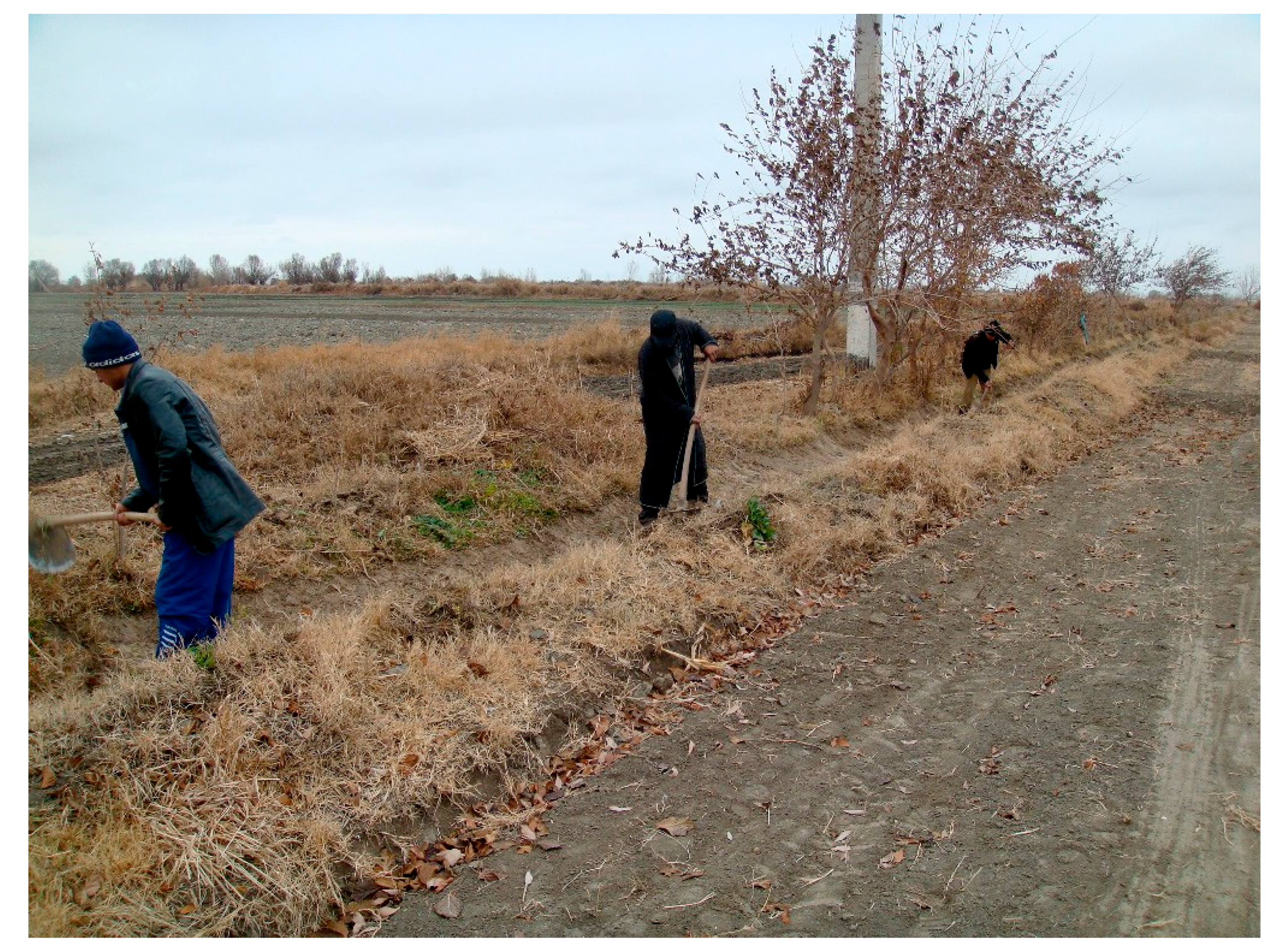Comparative Analysis of Nature-Related Transactions and Governance Structures in Pasture Use and Irrigation Water in Central Asia
Abstract
:1. Introduction
2. Conceptual Framework
3. Methods
4. Results and Discussion
4.1. Pasture Use in Kyrgyzstan
4.1.1. Jergetal Community
4.1.2. Rules in Use and Governance Structures
4.1.3. Informal Institutions in Pasture Use
4.1.4. Properties of Nature-Related Transactions
4.2. Irrigation Water Management in Uzbekistan
4.2.1. Khalach Kalti Water Consumer Association
4.2.2. Rules in Use and Governance Structures
4.2.3. Properties of Nature-Related Transactions
4.3. Exploring Interdependence between Properties of Transactions and Governance Structures
4.3.1. Comparing Nature-Related Transactions
4.3.2. Aligning the Difference in Nature-Related Transactions with Institutions and Governance Structures
5. Conclusions
Acknowledgments
Author Contributions
Conflicts of Interest
References
- Hamidov, A. Institutions of Collective Action for Common Pool Resources Management: Conditions for Sustainable Water Consumers Associations in Semi-Arid Uzbekistan. Ph.D. Thesis, Humboldt University of Berlin, Berlin, Germany, 2015. [Google Scholar]
- Kasymov, U. Designing Institutions in a Post-Socialist Transformation Process: Institutions in Regulating Access to and Management of Pasture Resources in Kyrgyzstan. Ph.D. Thesis, Humboldt University of Berlin, Berlin, Germany, 2016. [Google Scholar]
- Crewett, W. Improving the sustainability of pasture use in Kyrgyzstan: The impact of pasture governance reforms on livestock migration. Mt. Res. Dev. 2012, 32, 267–274. [Google Scholar] [CrossRef]
- Dörre, A. Legal arrangements and pasture-related socio-ecological challenges in Kyrgyzstan. In Pastoral Practices in High Asia; Kreutzmann, H., Ed.; Springer: Berlin, Germany, 2012; pp. 127–144. [Google Scholar]
- Steimann, B. Making a Living in Uncertainty: Agro-Pastoral Livelihoods and Institutional Transformations in Post-Socialist Rural Kyrgyzstan; University of Zurich: Zürich, Switzerland, 2011. [Google Scholar]
- Undeland, A. Kyrgyz Republic Livestock Sector Review—Embracing New Challenges; World Bank: Washington, DC, USA, 2005. [Google Scholar]
- Dukhovny, V.A.; Sokolov, V.I.; Ziganshina, D.R. Integrated water resources management in Central Asia, as a way of survival in conditions of water scarcity. Quat. Int. 2013, 311, 181–188. [Google Scholar] [CrossRef]
- Zavgorodnyaya, D. Water User Associations in Uzbekistan: Theory and Practice. Ph.D. Thesis, Center for Development Research, University of Bonn, Bonn, Germany, 2006. [Google Scholar]
- Zinzani, A. Hydraulic bureaucracies and irrigation management transfer in Uzbekistan: The case of Samarkand Province. Int. J. Water Resour. D 2016, 32, 232–246. [Google Scholar] [CrossRef]
- Farrington, J.D. De-development in eastern Kyrgyzstan and persistence of semi-nomadic livestock herding. Nomadic Peoples 2005, 9, 171–197. [Google Scholar] [CrossRef]
- Kerven, C.; Steimann, B.; Dear, C.; Ashley, L. Researching the future of pastoralism in Central Asia’s mountains: Examining development orthodoxies. Mt. Res. Dev. 2012, 32, 368–377. [Google Scholar] [CrossRef]
- Kreutzmann, H. Pastoral Practices in High Asia: Agency of Development Effected by Modernisation, Resettlement and Transformation; Springer: Berlin, Germany, 2012. [Google Scholar]
- Ludi, E. Sustainable pasture management in Kyrgyzstan and Tajikistan: Development needs and recommendations. Mt. Res. Dev. 2003, 23, 119–123. [Google Scholar] [CrossRef]
- Shigaeva, J.; Kollmair, M.; Niederer, P.; Maselli, D. Livelihoods in transition: changing land use strategies and ecological implications in a post-Soviet setting (Kyrgyzstan). Cent. Asian Surv. 2007, 26, 389–406. [Google Scholar] [CrossRef]
- Wright, I.A.; Malmakov, N.I.; Vidon, H. New patterns of livestock management: Constraints to productivity. In Prospects for Pastoralism in Kazakhstan and Turkmenistan: From State Farms to Private Flocks; Kerven, C., Ed.; Routledge Curzon: London, UK, 2003. [Google Scholar]
- Hamidov, A.; Thiel, A.; Zikos, D. Institutional design in transformation: A comparative study of local irrigation governance in Uzbekistan. Environ. Sci Policy 2015, 53, 175–191. [Google Scholar] [CrossRef]
- Jumaboev, K.; Reddy, J.M.; Muhammedjanov, S.; Anarbekov, O.; Eshmuratov, D. An innovative public-private partnership for irrigation extension in Fergana Valley of Central Asia. J. Agric. Ext. Rural Dev. 2013, 5, 21–30. [Google Scholar]
- Abdullaev, I.; Hassan, U.; Mehmood, M.; Herath, Y. The Reliability Improvement in Irrigation Services: Application of Rotational Water Distribution to Tertiary Canals in Central Asia; International Water Management Institute: Colombo, Sri Lanka, 2006. [Google Scholar]
- Veldwisch, G.J. Cotton, Rice and Water: The Transformation of Agrarian Relations, Irrigation Technology and Water Distribution in Khorezm, Uzbekistan. Ph.D. Thesis, University of Bonn, Bonn, Germany, 2008. [Google Scholar]
- Wegerich, K. Water User Associations in Uzbekistan and Kyrgyzstan: Study on Conditions for Sustainable Development; University of London: London, UK, 2000. [Google Scholar]
- Djumaboev, K.; Hamidov, A.; Anarbekov, O.; Gafurov, Z.; Tussupova, K. Impact of institutional change on irrigation management: A case study from southern Uzbekistan. Water 2017, 9, 419. [Google Scholar] [CrossRef]
- Moss, T.; Hamidov, A. Where water meets agriculture: The ambivalent role of the water users associations (WUAs). In Society–Water–Technology: A Critical Appraisal of Major Water Engineering Projects; Hüttl, R.F., Bens, O., Bismuth, C., Hoechstetter, S., Eds.; Springer International Publishing: Dordrecht, The Netherlands, 2015. [Google Scholar]
- Bucknall, J.; Klytchnikova, I.; Lampietti, J.; Lundell, M.; Scatasta, M.; Thurman, M. Irrigation in Central Asia: Social, Economic and Environmental Considerations; World Bank: Washington, WA, USA, 2003. [Google Scholar]
- Hagedorn, K. Particular requirements for institutional analysis in nature-related sectors. Eur. Rev. Agric. Econ. 2008, 35, 357–384. [Google Scholar] [CrossRef]
- Hagedorn, K. Natural resource management: The role of cooperative institutions and governance. J. Entrepr. Organ. Divers. 2013, 2, 101–121. [Google Scholar] [CrossRef]
- Williamson, O.E. The new institutional economics: Taking stock, looking ahead. J. Econ. Lit. 2000, 38, 595–613. [Google Scholar] [CrossRef]
- Hagedorn, K.; Arzt, K.; Peters, U. Institutional arrangements for environmental cooperatives: A conceptual framework. In Environmental Cooperation and Institutional Change: Theories and Policies for European Agriculture; Hagedorn, K., Ed.; Edward Elgar: Cheltenham, UK, 2002. [Google Scholar]
- Gatzweiler, F.; Hagedorn, K. The evolution of institutions in transition. Intern. J. Agric. Resour. Gov. Ecol. 2002, 2, 37–58. [Google Scholar] [CrossRef]
- Commons, J.R. Institutional economics. Am. Econ. Rev. 1931, 11, 648–657. [Google Scholar]
- Hagedorn, K. Nature-Related Transactions: Why Do They Require a Special Approach in Institutional Analysis. Available online: http://citeseerx.ist.psu.edu/viewdoc/summary?doi=10.1.1.554.9209 (accessed on 12 September 2017).
- Williamson, O.E. Comparative economic organization: The analysis of discrete structural alternatives. Adm. Sci. Q. 1991, 36, 269–296. [Google Scholar] [CrossRef]
- Williamson, O.E. The Economic Institutions of Capitalism: Firms, Markets, Relational Contracting; Free Press: New York, NY, USA, 1985. [Google Scholar]
- Beckmann, V. Transaction cost and environmental economics—Towards a new approach. In Workshop in Political Theory and Policy Analysis; Indiana University: Bloomington, Indiana, 2002. [Google Scholar]
- Thiel, A.; Schleyer, C.; Hinkel, J.; Schluter, M.; Hagedorn, K.; Bisaro, S.; Bobojonov, I.; Hamidov, A. Transferring Williamson’s discriminating alignment to the analysis of environmental governance of social-ecological interdependence. Ecol. Econ. 2016, 128, 159–168. [Google Scholar] [CrossRef]
- Williamson, O.E. Efficiency, power, authority and economic organization. In Transaction Cost Economics and Beyond; Groenewegen, J., Ed.; Springer: Dordrecht, The Netherlands, 1996. [Google Scholar]
- Menard, C. The economics of hybrid organizations. J. Inst. Theor. Econ. 2004, 160, 345–376. [Google Scholar] [CrossRef]
- Hamidov, A.; Helming, K.; Balla, D. Impact of agricultural land use in Central Asia: A review. Agron. Sustain. Dev. 2016, 36, 6. [Google Scholar] [CrossRef]
- Seawright, J.; Gerring, J. Case selection techniques in case study research—A menu of qualitative and quantitative options. Political Res. Q. 2008, 61, 294–308. [Google Scholar] [CrossRef]
- Isakov, A. Assessment of Land Conditions of Kyrgyz Republic with Respect to Grazing and Possible Development of Quoting System at the Local Governmental Level. Available online: http://naturalresources-centralasia.org/flermoneca/assets/files/Assessment%20of%20the%20land%20condition%20in%20the%20KR%20with%20respect%20to%20grazing..._EN.pdf (accessed on 12 September 2017).
- Ostrom, E. Governing the Commons: The Evolution of Institutions for Collective Action; Cambridge University Press: Cambridge, UK, 1990. [Google Scholar]



| Characteristics | Jergetal (Pasture User Union) | Khalach Kalti (Water Consumer Association) |
|---|---|---|
| Date of establishment of user organizations | March 2011, re-registered in April 2012 | October 2006 |
| Number of organization members | 104 | 34 |
| Total land area (ha) | 85,100 | 2073 |
| Resource units | Livestock (heads): Horses (2440) Sheep and Goats (27,706) Cattles (2857) Camels (41) Poultry (2084) | Crops (ha): Cotton (1069) Wheat (627) Other crops (377) |
| Infrastructure | 146 (bars) | 56 km (length of irrigation canals) |
| Total budget (Euro) | 6130 | 14,300 (with electricity cost included) |
| Collected amount (Euro) | 1800 | 5530 |
| Pasture fee collection rate (%) | 30 | 39 |
| Properties of Transaction | Provision of Fodder to Livestock (A) | Difference | Maintaining Irrigation Canals (B) |
|---|---|---|---|
| Modularity and functional interdependence | Low modularity and high functional interdependence | A < B | Moderate modularity and high functional interdependence |
| Excludability | Difficult, costly, but feasible (e.g., constructing bars and fencing) | A = B | Difficult but feasible (non-payers/non-contributors can be excluded) |
| Rivalry | Moderate, rivalry depends on pasture location and quality | A < B | Strong rivalry (finite resource) |
| Asset specificity | Moderate—requires asset-specific investments (livestock, bars, winter fodder and experienced herders) | A < B | High—canal maintenance requires knowledge, site and physically fixed, asset-specific investments |
| Frequency | High—this transaction is related to the seasonal variation of pasture productivity | A > B | Moderate (recurrent and seasonal but not regular) |
| Uncertainty | High as many factors may affect outcome | A > B | Relatively certain (action-outcome linkage) |
| Separability/Jointness in production | Low due to diversification of income-generating activities | A < B | Separable—transaction related to the outcome |
| Complexity | High—the causal relationship between pasture use and related problems, such as overgrazing and degradation, is complex | A = B | High—due to complex relationship between human-designed and natural system |
| Heterogeneity/Variability | High—transaction depends on many factors: the seasonal productivity of a pasture, the distance, location and exposure of pastures, weather and precipitation etc. | A > B | Non-heterogeneous—irrigation canal maintenance has no spatial implications. |
| Measurability | Low (e.g., unreliable statistics on livestock) | A < B | Measurable—cost and benefit streams emerging from canal maintenance can be identified and assessed |
| Reversibility and irreversibility | Low as a limited amount of irrigated and rain-fed land is available for fodder production | A < B | Reversible—drainage canals provide alternative source of resources |
| Legitimacy | High—highly respected as a traditional practice and important for securing the livelihood of the community | A = B | Highly legitimate—association sanctions actors who do not participate in canal maintenance |
| List | Mal Koshuu and Pasture Use Plan | Difference | Khashar and Water Use Plan |
|---|---|---|---|
| Pooling | Low modularity, measurability, reversibility and high variability of the transaction reflects the high coherence of the non-designed natural system that is pooled in this type of hybrid institutional arrangement | Human designed vs. natural systems | Moderate modularity, measurability, reversibility and variability of the transaction is related to the fact that the human designed system is pooled in this type of institutional arrangement |
| Contracting (coordination of individual choices) | High uncertainty, high frequency and moderate asset specificity require flexibility of institutional arrangements and need less protective governance | Need for protective governance | Moderate uncertainty, moderate frequency and high asset specificity require more protective governance |
| Competition (rules for benefit sharing and dispute resolution) | Low excludability and medium rivalry within and between communities create relatively high competition and social dilemma | Level and scale of social dilemma | Low excludability and high rivalry within WCA leads to high competition and social dilemma |
© 2017 by the authors. Licensee MDPI, Basel, Switzerland. This article is an open access article distributed under the terms and conditions of the Creative Commons Attribution (CC BY) license (http://creativecommons.org/licenses/by/4.0/).
Share and Cite
Kasymov, U.; Hamidov, A. Comparative Analysis of Nature-Related Transactions and Governance Structures in Pasture Use and Irrigation Water in Central Asia. Sustainability 2017, 9, 1633. https://doi.org/10.3390/su9091633
Kasymov U, Hamidov A. Comparative Analysis of Nature-Related Transactions and Governance Structures in Pasture Use and Irrigation Water in Central Asia. Sustainability. 2017; 9(9):1633. https://doi.org/10.3390/su9091633
Chicago/Turabian StyleKasymov, Ulan, and Ahmad Hamidov. 2017. "Comparative Analysis of Nature-Related Transactions and Governance Structures in Pasture Use and Irrigation Water in Central Asia" Sustainability 9, no. 9: 1633. https://doi.org/10.3390/su9091633






